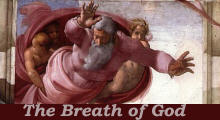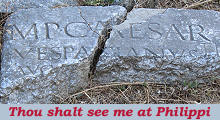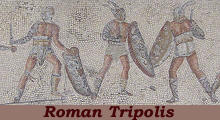  What's New! Detailed Sitemap All images © by Roberto Piperno, owner of the domain. Write to romapip@quipo.it. Text edited by Rosamie Moore. Page added in June 2011. |
  - Christian communities in Syria: Maaloula - Christian communities in Syria: Maaloula(God dividing Water from Heaven, fresco by Michelangelo, Sistine Chapel, Rome) Qalamoun is a tableland in southern Syria which is located north-west of Damascus; it is part of the Anti-Lebanon mountains.
The area of Qalamoun where the small town of Maaloula is located is characterized by high rocks which can be relatively easily carved to enlarge natural caves; this led to the site being inhabited at a very early stage.
The rocks near Maaloula have many cracks which sometimes pierce them from side to side and allow the passage of men and animals; it is likely that the inhabitants of the town used them to escape in case of danger.
The longest of these passages is associated with the life of Saint Techla, one of the first followers of St. Paul. According to IInd century accounts she lived in the Anatolian tableland and she eventually died at Seleucia ad Calicadnus where a large basilica was built above a cave where she hid from her persecutors.
A similar account developed around a cave in Maaloula where the saint was helped to escape from her persecutors by the miraculous opening of a crack into the rock. In the centuries which followed the Arab invasion of Syria, the Christian communities of Qalamoun lived in isolation and they probably relocated popular events which had occurred elsewhere to their own environment.
The long and sometimes very narrow passage became a holy site and many tombs were carved into the nearby rocks; today the passage is the main attraction of Maaloula and buses unload tourists at one end and pick them up at the other.
Maaloula (the name means the passage, the gorge) is located at some 5,000 ft of altitude in a sort of natural theatre formed by the rocks at the sides of al-Fajj; most of the inhabitants are Christians (belonging to various churches); until a few decades ago Aramaic was widely spoken and there are some recorded speeches in the language of Jesus Christ.
The two main monasteries of Maaloula are located at the opposite ends of the small town; today Maaloula enjoys some wealth from being visited by many foreigners; tourists, but also believers who remain for an extended period and who are attracted by the town's religious tradition, by the past usage of Aramaic and by a very evocative landscape.
A large and mostly modern Greek Orthodox convent was built near the cave where the saint lived and where holy water drips from the vault; it is interesting to note that the faithful have to remove their shoes to enter the cave; it is a Muslim practice which has been adopted by the local Christians; the image which appears in the background of this page is based on a modern portrait of Saint Thecla.
The monastery of Sts. Sergius and Bacchus is regarded among the oldest ones on Earth; the analysis of its logs indicates that they were cut 2,000 years ago; the original building however is encased in a modern construction and the icons in the interior are not very old; the altar instead has probably a pagan origin or it was designed having in mind pagan altars.
A small temple to the sun cut into the rock has been discovered a few hundred yards from the monastery; at the time of our visit (February 2011) the temple was about to be incorporated into the garden of a luxury hotel. Move to: Qara Ezra Map of Syria with all the locations covered in this website     |









